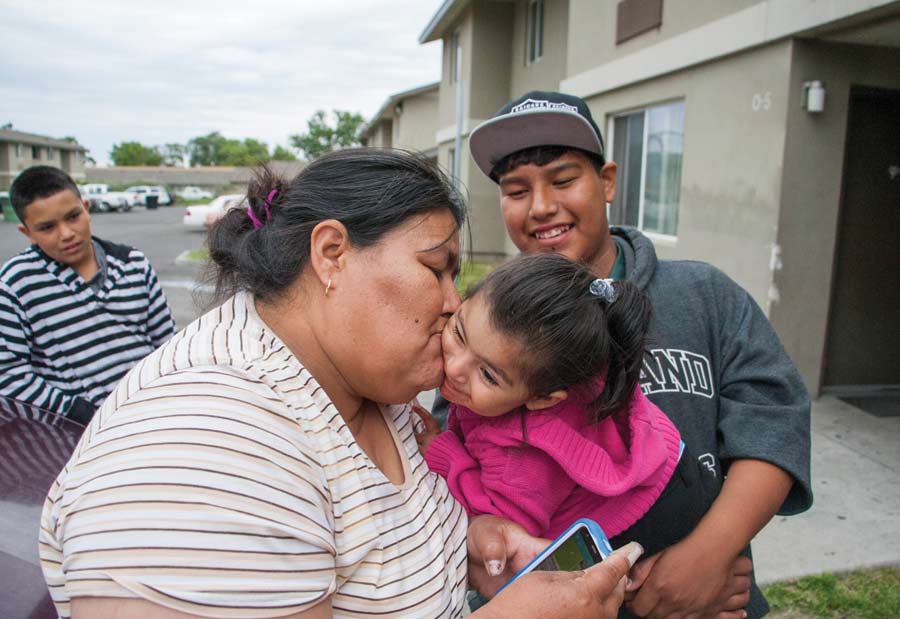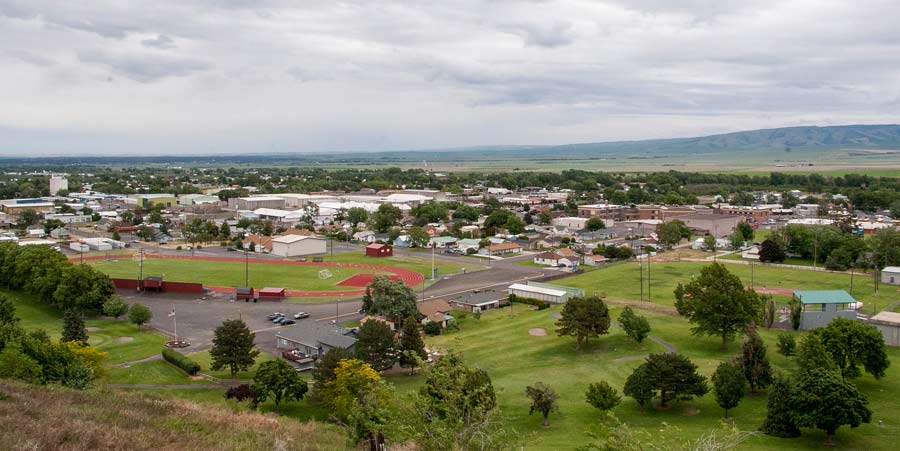
Beatriz Lara bids farewell to her granddaughter Ana Robledo outside Lara’s apartment at the Orchard Homes farmworker housing facility in Milton-Freewater, Oregon, in May. Holding Robledo is Lara’s son Javier Lara. The family lives at the complex year-round while working in nearby orchards. The farmers who own the building would like to use it to house visiting H-2A workers, but their U.S. Department of Agriculture loan requirements restrict the facility to U.S. citizens and permanent residents. (Ross Courtney/Good Fruit Grower)
In Milton-Freewater, Oregon, many people still call the Orchard Homes farmworker housing facility “the labor camp” after its 1950s origin as quarters for traveling field laborers, who stayed for a month or so before moving on.
Obviously, times have changed.
Today, about half of the units in Orchard Homes, an apartment facility built by area farmers specifically to house seasonal laborers, are occupied by year-round residents, but the younger generations of workers are seeking work outside the fields, vineyards and orchards that line the Walla Walla Valley in this corner of northeast Oregon.
As a result, Orchard Homes lacks enough residents, and the nonprofit grower organization that owns it has been dipping into reserves to make its loan payments to the U.S. Department of Agriculture.
The growers would like to house the new wave of migrant laborers — foreign guest workers on H-2A visas — but can’t because their loan limits them to housing U.S. residents.
Growers considering joining the wave of building apartments for foreign workers should view the Orchard Homes tale as cautionary when they seek funding and steer away from a popular federal program that restricts money to structures for domestic workers only, the same one now tying the hands of the Milton-Freewater facility.
“We had a perfect housing infrastructure to bring H-2A workers in, but we can’t use that structure, and it’s going broke because we can’t use it,” said Tom Waliser, a Milton-Freewater apple and grape grower and member of the housing facility’s board of directors.
The group owes about $1.4 million on its loan, Waliser said. Vacancies have left it low on short-term cash flow.
Either the farmers must fill more vacant units with seasonal workers or completely renovate the complex into attractive permanent apartments, a multi-million-dollar project they can’t afford.
One solution may be to turn over the keys to another organization outside of the agricultural industry.
“If we have to make it more attractive year-round housing, somebody else is going to have to do that,” Waliser said.
Policy problem
It’s a common quandary throughout the nation, hitting growers in Michigan, New York and other places increasingly relying on H-2A workers.
Diane Kurrle, senior vice president of the U.S. Apple Association, has been lobbying with no success to change the requirements of the loan program, the USDA’s Farm Labor Housing Direct Loans and Grants Program, sometimes called 514 funding.
“Obviously we recognize this as a government policy that doesn’t make sense and we’re trying to fix it,” said Kurrle, the main lobbyist for the Vienna, Virginia, organization.
The problem requires a legislative fix. In the past, the group and other organizations have pushed for one through the Farm Bill or appropriations bills, but supporters always run up against the same gridlock that has prevented the U.S. Congress from passing immigration reform.
They tried again with a round of letters to lawmakers earlier this year.
In the meantime, Kurrle advises growers to avoid the 514 program if they ever might consider hiring H-2A workers.
U.S. Rep. Dan Newhouse, R-Sunnyside, Washington, supports loosening the loan requirements on a priority basis; domestic workers would get first dibs on rooms, and H-2A workers could be housed in them only if there are rooms remaining.
“It’s an inefficient use of taxpayer dollars if farm housing is being underutilized or sitting empty because there are not enough domestic farm workers to fill available housing,” Newhouse’s office said in an email to Good Fruit Grower. “It’s in the best interest of taxpayers and farmers to make sure USDA services are being used to their full extent, including allowing H-2A workers access to 514 housing if there are insufficient domestic workers to fill available units.”
The farm labor program is not the only funding source for growers who need labor housing, but others often are intended only for nonprofit organizations, said Jon DeVaney, president of the Washington State Tree Fruit Association in Yakima, Washington.
Banks don’t always want to front capital for growers’ worker housing costs because “it’s a big expense that doesn’t necessarily cash flow well.”
History of Orchard Homes

Orchard Homes is Milton-Freewater, Oregon, was built in the 1950s to house workers during fruit harvest. Today, most residents live there year-round. (Ross Courtney/Good Fruit Grower)
The “camp” started in the 1950s when farmers picked up day laborers — mostly white, male veterans of World War II and Korea, many of them transient, Waliser said.
In the 1960s and 1970s, it was families from the south and later Mexican immigrants, as the size and variety of crops increased and the agricultural season stretched from weeks to several months.
In the 1970s, a group of area farmers used a federal loan to rebuild the apartments and another to renovate it in the early 2000s, he said.
Since then, migrant labor has been fading. Northwest growers complain of labor shortages of up 20 percent or more.
“As a result of that, our occupancy in the camp has dwindled down in the last decade,” Waliser said.
Farm laborers save up to buy their own homes more than they did in the 1990s, said Jaime Garcia, a former resident and former chairman of the facility’s board of directors. Also, a newer labor housing facility opened in Walla Walla, just eight miles north in Washington, competing for residents.
Garcia would favor letting H-2A residents live at orchard homes. That would help fill the facility and help growers find workers.
“They are scarce of people,” Garcia said.
Angelica Medina, a former resident and teacher at the preschool next door has fond memories of playing with friends while her parents worked at the Green Giant asparagus canner in nearby Dayton, Washington, and paid their rent in cash every week.
“Back then, to me, they were beautiful,” Medina said.
It was also full, with a long waiting list.
For five years straight, her mother drove from Mexico, stopping to use a payphone at the Madras, Oregon, Safeway, to inform the manager the family was on its way.
Medina has noticed the change, too. Green Giant closed in 2015. Other packing houses and processing facilities have followed suit, while migrants have settled, switching to construction or landscaping work.
“A lot of people are buying houses and they are settling here,” Medina said. “They aren’t going back and forth.”
Life at Orchard Homes
The residents of Orchard Homes pay a sliding scale, live across the street from a Safeway and next door to a preschool where many of their children spend their days.
Beatriz Lara has lived in the apartments year-round with her husband and family for nearly eight years. Not moved out once. She carpools about 45 miles west each morning to her job at a Broetje Orchards property in Wallula, Washington.
She describes her home the way many families would an apartment complex: decent but not perfect and definitely not temporary. It has a playground and central heat and air, while managers help her keep tabs on her children with the security cameras. However, sometimes the laundry machines don’t work, vandalism occurs and she wishes the grass was watered more often.
But it’s home. “I feel comfortable here,” she said.
– by Ross Courtney






Leave A Comment